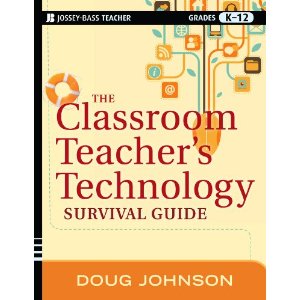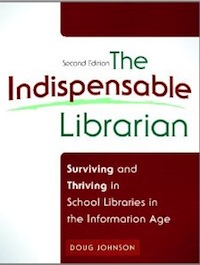Six Ways to Beat the Study Hall Syndrome
Six Ways to Beat the Study Hall Syndrome in Your Media Center
Head for the Edge. Technology Connection, November 1995
A media specialist new to the profession recently asked me, “How does one keep a media center from becoming a studyhall, recreation area, or dumping ground for students?”
Ah, this was a battle I also seemed to fight over and over in my 12 years as a building media specialist. In every school and at all grade levels, some teachers and administrators often saw the media center as a “holding area.” I believe it is an endemic problem.
To get to the heart of the problem, it helps to understand that education is only one of three tasks with which society has given its schools. The other two - child confinement and child socialization - seem to be particularly apparent in the unstructured areas of the school: the hallways, lunchrooms, and media centers. Of these areas where students have freedom of movement, discretionary time, and a choice of activities, the media center is the only one which has an academic mission as well. While we need to acknowledge that media centers must share the school’s obligation to contain children and must honor children’s need to socialize, media specialists can and should bring the academic mission to the fore.
So how can we do this?
1) Schedule plenty of meaningful activities
If the media center is being used by whole classes doing research or other kinds of study, the physical plant will not accommodate large numbers of non-directed students. The teachers of the classes using the media center will help support and enforce a climate of purposeful activity.
2) Add technology to your area
Tables full of idle children tend to cause problems; students at computer terminals, whether involved in writing, searching, drawing, or even playing, rarely do. While I have never felt it was the school’s job to entertain children, I certainly believe it is our duty to involve them. And few things involve this generation of kids like interactive media. Fill your media centers with technology, not empty tables.
3) Share your space with other big people
The more adults in your media center, the more likely you are to have a productive area. Make a space for an adult-run study skills center, the talented and gifted program, space for parent volunteers, or other academic support programs which need a home. The old idea of the library being a hushed room behind closed doors is passe. Work is not always a quiet activity; learning is usually accompanied by terrific sounds: laughs, questions, instructions, sharing, surprises.
4) Have few rules
All my media centers, K-12, operated under three simple rules for all patrons. To stay in the media center one needed to:
If I were to run a media center again, I might just adopt the one rule that governs the Glen Urquhart School in Massachusetts, that “No student has the right to interfere with the learning of another student or the purpose of an activity.” The key to simple rules is working with children and teachers on common understandings and applications of them. For example, is reading a magazine being productive? Is napping? Is cartooning? Is playing Oregon Trail? Consistent enforcement of such rules is challenging, but good for kids who as adults will be asked to apply guidelines to their behaviors, rather than only adhere to set rules.
5) Provide alternate activities
Have things for students to do who do not seem to have school work. Provide books, newspapers and magazines for personal interest reading. (Reading practice materials, I like to call them.) Design activities like reference scavenger hunts, puzzle centers, or individual viewing of filmstrips or videotapes. Save a few tasks for the physically restless students: putting up bulletin boards, reshelving materials, dusting, shelf reading, collection mapping, equipment maintenance, magazine check-in, disk duplicating, or newspaper bundling.
6) Change the school climate
Teachers and the principal of your school need to share your vision of the media center as a place for work, for learning, for productivity. If they don’t, your job will be nigh on impossible. You can change the views of your staff by sharing successes your program has afforded students. Educate teachers about current media center philosophies and your goals. Serve on your site-based management team to make good school policies and rules - especially those which apply to your media center. Work to change teaching strategies so that the resources the media center provides are essential to the educational process. Help your school find other options for the containment and socialization functions of the school - restructured days without studyhalls, student commons, open gymnasiums, intelligent schedules, etc.
Folks, we all work in the real world. I have had plenty of studyhalls in my media centers when the principal simply couldn’t find another room large enough. Plenty of my patrons have been the kids a teacher or studyhall monitor simply couldn’t stand for another minute. Some kids have come to my media center for every reason under the sun but to study. Did I ever create a perfect learning environment - an intellectual gymnasium? Nope.
But I know that my media centers were places kids found interesting, safe, non-threatening, rich in interesting materials and activities - not to mention sort of helpful when they needed information. As one of favorite classroom “ejects” occasionally reminded me,”Mr. Johnson, the media center is my home away from home.” High praise.
Head for the Edge. Technology Connection, November 1995
A media specialist new to the profession recently asked me, “How does one keep a media center from becoming a studyhall, recreation area, or dumping ground for students?”
Ah, this was a battle I also seemed to fight over and over in my 12 years as a building media specialist. In every school and at all grade levels, some teachers and administrators often saw the media center as a “holding area.” I believe it is an endemic problem.
To get to the heart of the problem, it helps to understand that education is only one of three tasks with which society has given its schools. The other two - child confinement and child socialization - seem to be particularly apparent in the unstructured areas of the school: the hallways, lunchrooms, and media centers. Of these areas where students have freedom of movement, discretionary time, and a choice of activities, the media center is the only one which has an academic mission as well. While we need to acknowledge that media centers must share the school’s obligation to contain children and must honor children’s need to socialize, media specialists can and should bring the academic mission to the fore.
So how can we do this?
1) Schedule plenty of meaningful activities
If the media center is being used by whole classes doing research or other kinds of study, the physical plant will not accommodate large numbers of non-directed students. The teachers of the classes using the media center will help support and enforce a climate of purposeful activity.
2) Add technology to your area
Tables full of idle children tend to cause problems; students at computer terminals, whether involved in writing, searching, drawing, or even playing, rarely do. While I have never felt it was the school’s job to entertain children, I certainly believe it is our duty to involve them. And few things involve this generation of kids like interactive media. Fill your media centers with technology, not empty tables.
3) Share your space with other big people
The more adults in your media center, the more likely you are to have a productive area. Make a space for an adult-run study skills center, the talented and gifted program, space for parent volunteers, or other academic support programs which need a home. The old idea of the library being a hushed room behind closed doors is passe. Work is not always a quiet activity; learning is usually accompanied by terrific sounds: laughs, questions, instructions, sharing, surprises.
4) Have few rules
All my media centers, K-12, operated under three simple rules for all patrons. To stay in the media center one needed to:
- be doing something productive
- be doing it in a way that allowed others to be productive
- be respectful of others’ persons and property.
If I were to run a media center again, I might just adopt the one rule that governs the Glen Urquhart School in Massachusetts, that “No student has the right to interfere with the learning of another student or the purpose of an activity.” The key to simple rules is working with children and teachers on common understandings and applications of them. For example, is reading a magazine being productive? Is napping? Is cartooning? Is playing Oregon Trail? Consistent enforcement of such rules is challenging, but good for kids who as adults will be asked to apply guidelines to their behaviors, rather than only adhere to set rules.
5) Provide alternate activities
Have things for students to do who do not seem to have school work. Provide books, newspapers and magazines for personal interest reading. (Reading practice materials, I like to call them.) Design activities like reference scavenger hunts, puzzle centers, or individual viewing of filmstrips or videotapes. Save a few tasks for the physically restless students: putting up bulletin boards, reshelving materials, dusting, shelf reading, collection mapping, equipment maintenance, magazine check-in, disk duplicating, or newspaper bundling.
6) Change the school climate
Teachers and the principal of your school need to share your vision of the media center as a place for work, for learning, for productivity. If they don’t, your job will be nigh on impossible. You can change the views of your staff by sharing successes your program has afforded students. Educate teachers about current media center philosophies and your goals. Serve on your site-based management team to make good school policies and rules - especially those which apply to your media center. Work to change teaching strategies so that the resources the media center provides are essential to the educational process. Help your school find other options for the containment and socialization functions of the school - restructured days without studyhalls, student commons, open gymnasiums, intelligent schedules, etc.
Folks, we all work in the real world. I have had plenty of studyhalls in my media centers when the principal simply couldn’t find another room large enough. Plenty of my patrons have been the kids a teacher or studyhall monitor simply couldn’t stand for another minute. Some kids have come to my media center for every reason under the sun but to study. Did I ever create a perfect learning environment - an intellectual gymnasium? Nope.
But I know that my media centers were places kids found interesting, safe, non-threatening, rich in interesting materials and activities - not to mention sort of helpful when they needed information. As one of favorite classroom “ejects” occasionally reminded me,”Mr. Johnson, the media center is my home away from home.” High praise.
Posted on Thursday, July 5, 2007 at 07:55AM
by
 Doug Johnson
in Head for the Edge column
|
Doug Johnson
in Head for the Edge column
|
 Post a Comment
Post a Comment





Reader Comments